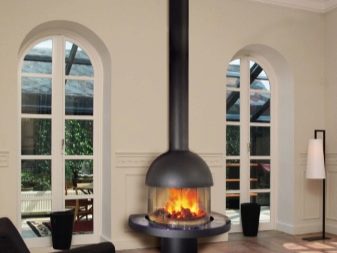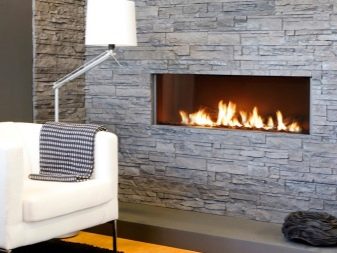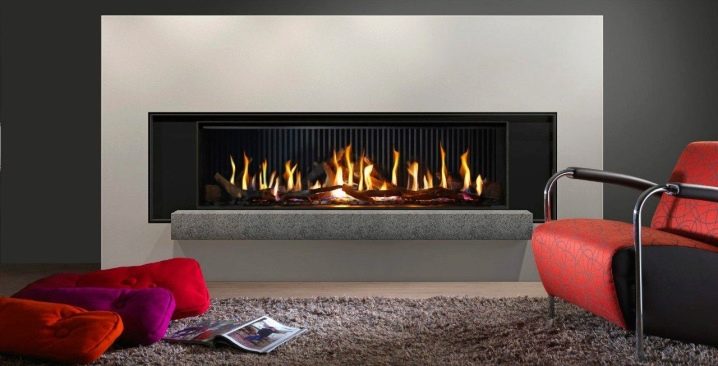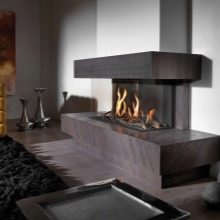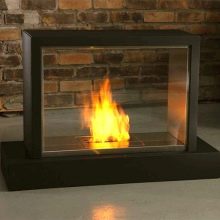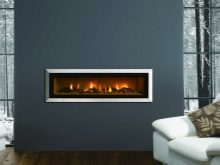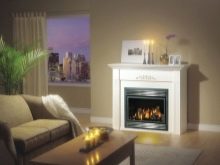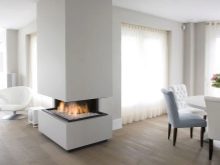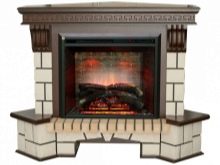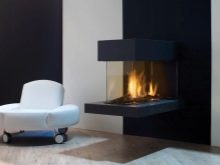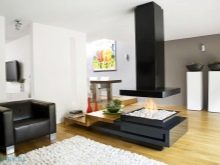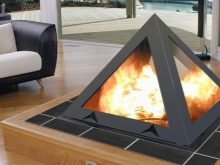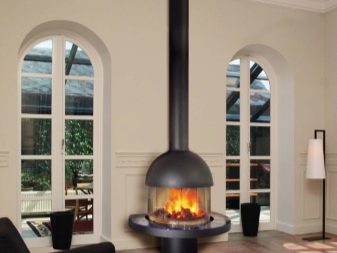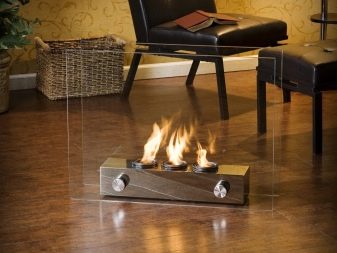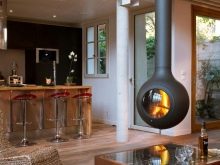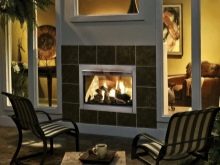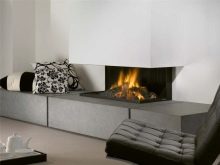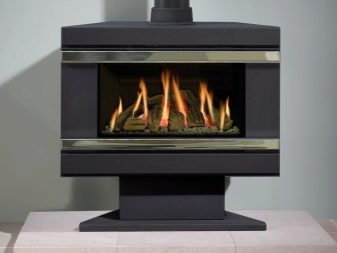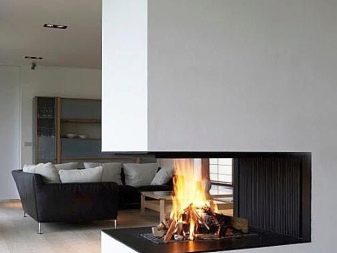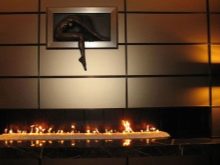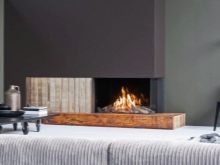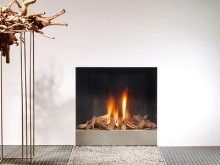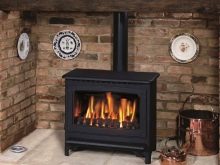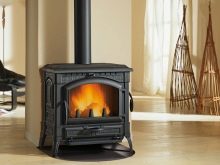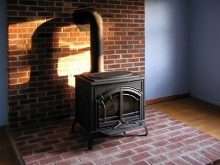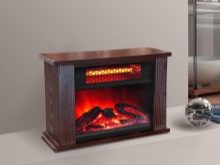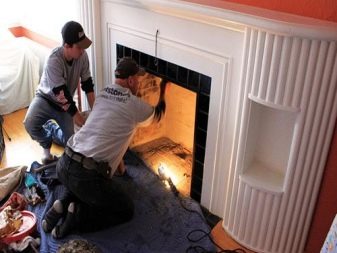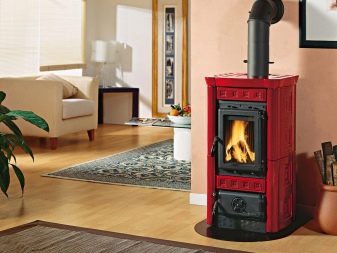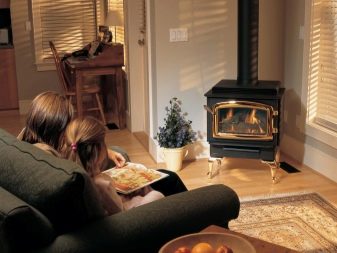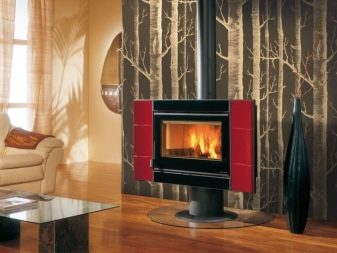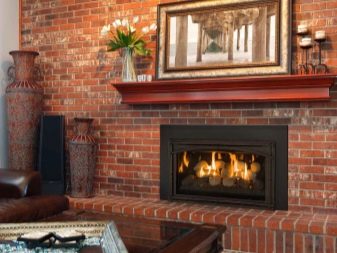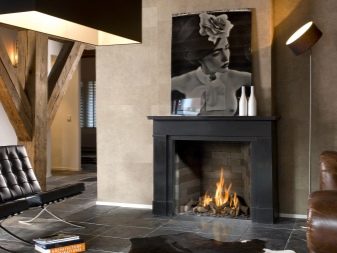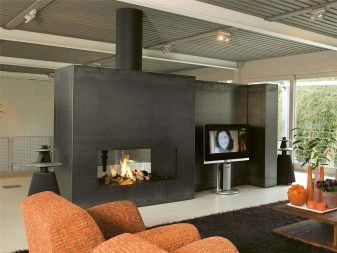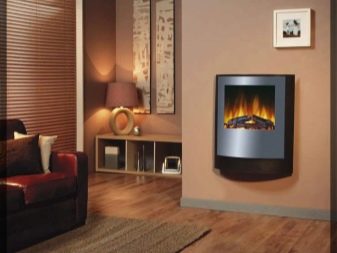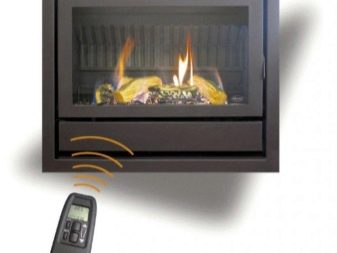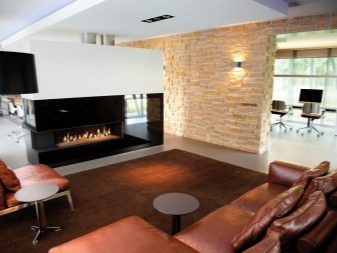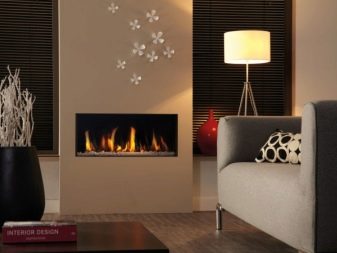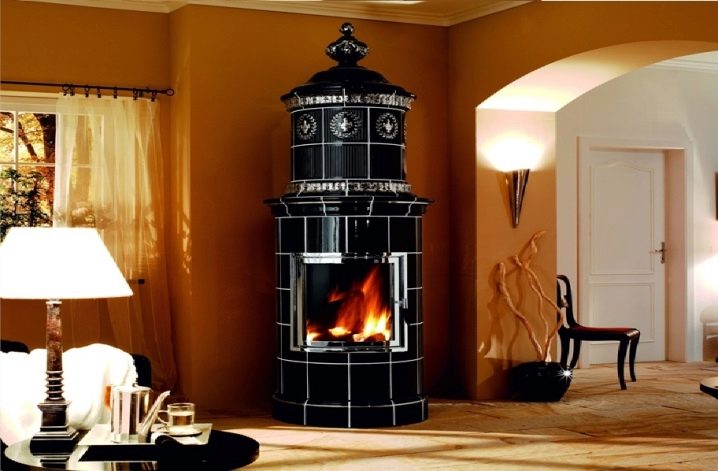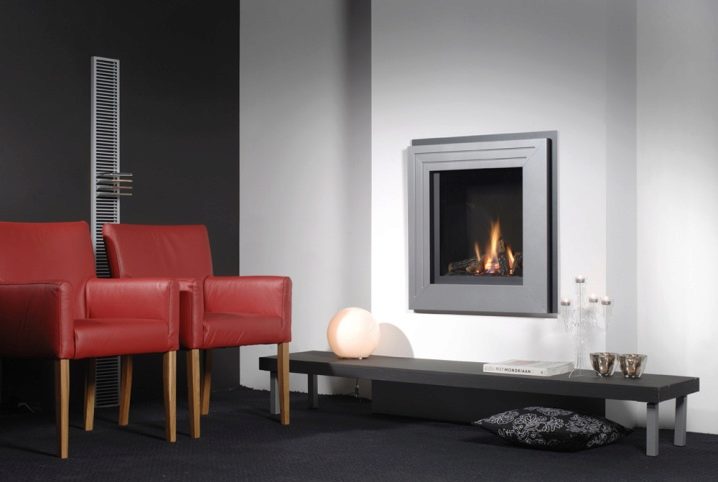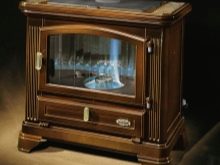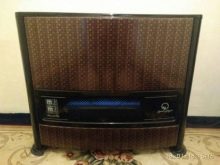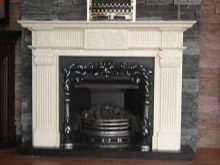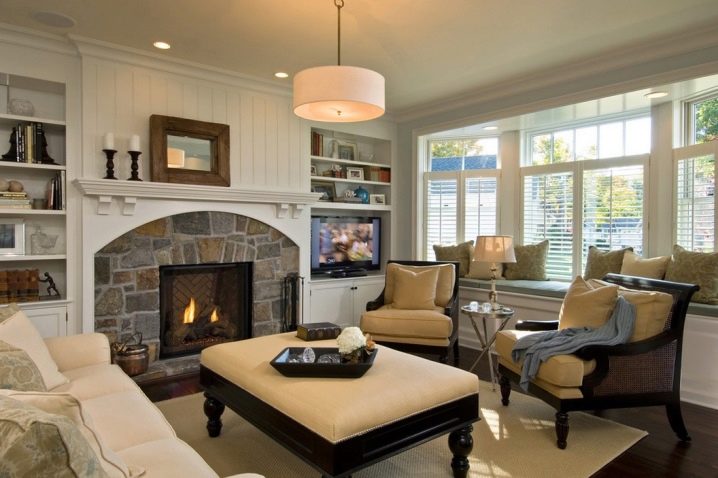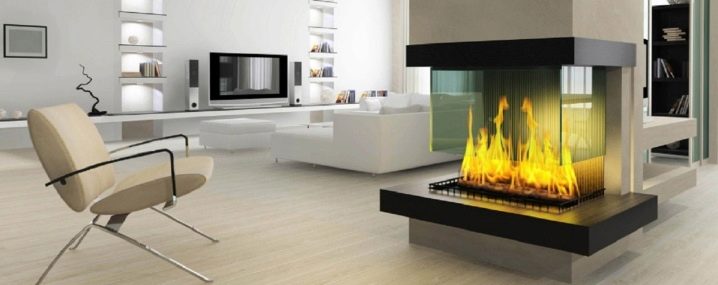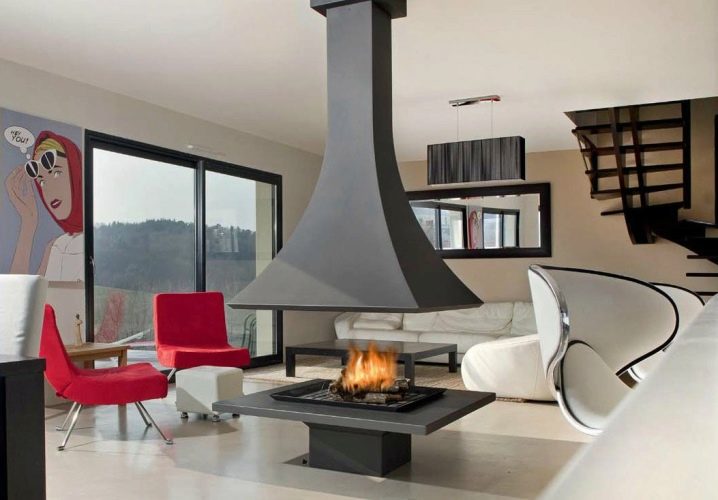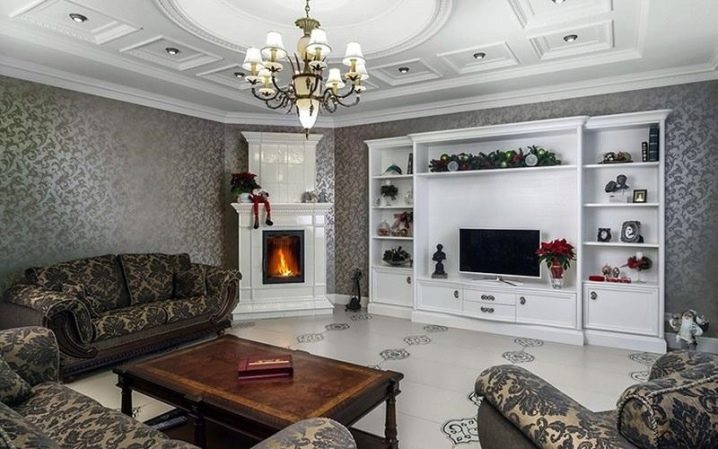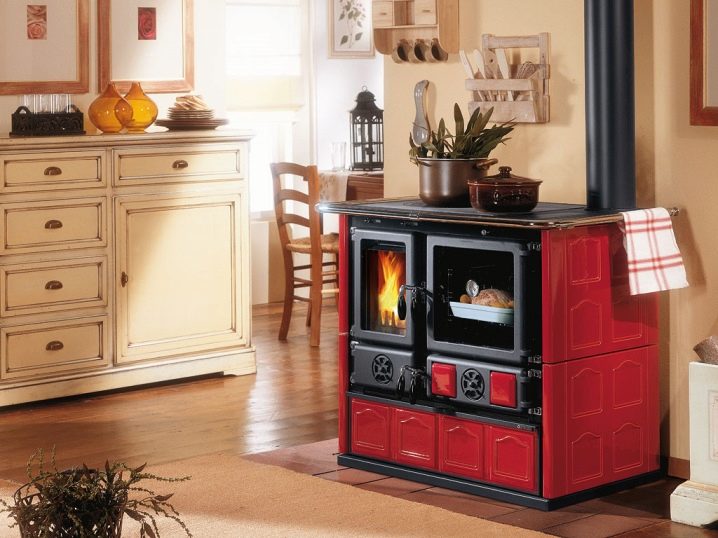Gas fireplace in interior design

As you know, you can watch the burning fire endlessly. This is partly why fireplaces are gaining increasing popularity among the owners of private houses and apartments. One of the modern, safe and economical options - a fireplace for gas.
Special features
Gas fireplace has a special burner that provides a burning effect and is located in a cast-iron housing. The latter is protected by heat-resistant glass.
The fuel is propane-butane or ordinary gas that is used for cooking. For convenience, the fireplace can be connected to the existing system and kitchen ventilation. However, for it is allowed to use a separate balloon.
Fireplaces on gas have several advantages.
- Increased efficiency - 85% and high power, amounting to 10-15 kW. The burning temperature of the gas is 500-650C. This allows the use of equipment for heating. In addition, the distribution of air blowers throughout the apartment heat is distributed everywhere. And it does not go up (as it happens when heated with wood counterparts), but inside the room.
- Safety, that is, gas leakage and sparking out of sparks are excluded due to the use of a sealed chamber.
- Lack of soot and soot, smoke, the need to organize a place to store firewood.
- Easy installation due to low exhaust gas temperature (150-200C). It is in connection with this possible simplification of the organization of the chimney.
- Simplicity and automation of combustion processes - you can ignite the firebox using the remote control button or by turning the thermostat slider.
- The variety of sizes and shapes of gas equipment, due to the lack of need to use solid fuel.
- The possibility of using bottled or main gas, which expands the possibilities of using the fireplace.
- Exact imitation of a flame, and also an opportunity to regulate its power.
- The high rate of heating of the fireplace - just a few minutes after switching on, requires that it start heating the room.
Kinds
There are many varieties of gas fireplaces. Their classification can be based on various characteristics.
Depending on where in the apartment or country house the device is mounted, it can be of several types.
- Corner. Installed in a corner of the room, well suited for small rooms, because they are ergonomic and compact.
- Embedded also differ in compactness, as they are mounted in a niche of the wall - self-made or finished. The portal should be trimmed with non-combustible materials, the fireplace is connected to the chimney.
- Wall is attached to the wall with brackets. The best option for families with small children and animals that can burn.
- Floor installed on a pre-mounted base and is connected to the chimney. May be in the form of a table, for which such devices are called fireplaces-tables.
- Frontal. Proceeding from the name it is clear that it is mounted in the center of the room.
- Open or streetinstalled in open areas (in gazebos, verandas) do not require a chimney.
For private buildings, you can choose any version of the fireplace, because the chimney can be “started up” through walls or floors. For an apartment building, front and corner versions are chosen, which are placed near or along the outer walls. Through them and mount the chimney.
If we talk about the possibility of transporting equipment, then there are:
- stationary, that is, those fireplaces that are not subject to further transportation after installation;
- portable ones are a small stove that can be rearranged from room to room.
When the classification is based on power characteristics, Fireplaces can be divided into the following groups:
- high power;
- average power;
- low power.
On average, for heating 10 square meters. m fireplace must give 1 kW. Manufacturers indicate not only the power of the device, but also prescribe the maximum area of the room that can be heated. However, when the fireplace is used only in summer (for example, at night) or as an additional source of heating, then 1 kW is enough for 20-25 square meters. m square.Finally, when choosing a device solely for decorative purposes, you can ignore the indicators of its efficiency.
Based on the type of fuel used, gas fireplaces are divided into those that work:
- on domestic gas - devices operating on this type of fuel are labeled "N";
- on propane-butane (assume the presence of a cylinder with gas) - the devices have the letter "P".
Depending on the appearance of the fuel outlet emit equipment:
- with open fire chambers - characterized by low efficiency (16%), but the ability at any time to observe the burning flame;
- with closed fireboxes - they have a closing glass door, due to which the efficiency of the fireplace reaches 70-80%, and if you wish, you can not close the door and admire the flames burning from the burner.
Depending on the direction of the radiated heat, fireplaces are:
- unilateral radiation - are considered the most effective (maximum efficiency), and therefore the most common;
- bilateral radiation - less effective, more decorative function, require a large amount of fresh air in the room;
- three-sided - differ in aesthetic appeal and a variety of forms, but have a small heat transfer;
- fireplaces with a heat exchanger, including a heat block and pipes through which heat is transferred throughout the house. Coolant is water (in winter it can be antifreeze), which moves from the heating unit through pipes.
Depending on the material from which the firebox is made, fireplaces can be:
- Steel - have a short lifetime, because the condensate released in the process of gas combustion quickly destroys the material.
- Cast iron are more resistant to the effects of condensate, because they contain graphite, and such models are heavier and more expensive.
- From the "stainless steel", which is resistant to the effects of acids, they have the longest service life compared with the previous two options, and hence the highest cost.
Based on the features of the forms and functioning, there are several more types of fireplaces.
- Made of cast iron or steel - they have an external surface lined with heat-resistant bricks and a door made of heat-resistant glass.The indicator of full efficiency - 50%.
- Fireplace boilers are rather heaters with portals. Externally, the device looks like a fireplace, it is possible to regulate its power.
- Infrared devices that heat a room with infrared waves or by heating a ceramic plate are characterized by safety, the absence of ash. Operate on propane-butane, suitable for installation both indoors and outdoors.
- Convectors - another type of heater, externally similar to the fireplace.
All of these models can have a more or less wide range of additional systems, be equipped with various lighters, have additional accessories.
How to do it yourself?
Depending on the type of device, its installation can be done by hand or by an engaged expert.
Do not forget that the installation of a gas fireplace requires coordination with the supervisory authorities, the exception is outdoor fireplaces.
When connecting the main type of equipment, you must trust his gas service specialist, because even kitchen stoves require professional connection.And with the wrong organization of the fireplace high risk of gas leakage.
When home-made installation of equipment requires that all its elements meet the following requirements:
- gas pipes should not be mounted in the wall, but only run on the surface of the walls;
- all connections must be leak tight to avoid gas leaks;
- premises where installation is planned must have a good ventilation system;
- the firebox should not be located in a draft;
- to the place where the convector or any other type of device will be located, it is necessary to supply electricity. Without it, it will not be possible to organize the system of automatic on / off, thermoregulation;
- It is important to ensure the moisture resistance of the chimney, since carbon dioxide is emitted during the combustion process — it is best to wrap a non-combustible insulation stainless pipe;
- non-flammable materials, such as heat-resistant bricks, ceramic tiles, natural or artificial stone, should be used for cladding.
Step by step instructions for installing a gas fireplace varies depending on its type and features of the room, so we give only the most significant and general rules.
- The main element of the device is a burner, which is surrounded by an artificial material with a heat-resistant material. Depending on the type of the latter, you can achieve one or another style of the finished accessory.
- To increase heat transfer, the inner walls of the firebox should be expanded from the outside. Here heat resistant doors are mounted.
- Under the furnace part have a control unit, which is insulated with insulating material.
- The walls of the smoke box, on the contrary, have a narrowing in the upper part, which ensures the output of combustion products into the chimney.
- The chimney for gas appliances may have a smaller diameter than the analogue for wood fireplaces. However, the first must turn around moisture and fire resistant characteristics.
The work of the fireplace is more convenient to manage automatically. To do this, it should be equipped with sensors for carbon dioxide level and tipping. They are included to prevent carbon dioxide emissions by covering the fuel supply.
When reducing the intensity of combustion for gas supply in this case also applies a special automated device.To maintain a constant temperature in the room allows an electric thermostat mounted on the fireplace.
Tips and tricks
First of all, you should decide on the place of installation of the fireplace, identify the features of the load-bearing walls, rafters and ceiling beams. After that, mentally pave the way pipes. They can not be too bent or hidden in the wall. This is unsafe, and in the event of a malfunction - inconvenient.
The next parameter is the size of the fireplace and its power. For large premises of about 100 square meters. m, you can choose a large device with a capacity of 10-12 kW.
Pay attention to the presence of additional systems (their presence often allows you to avoid unscheduled support and repair) and accessories. For example, to turn on the fireplace is much more convenient with the remote control. Special devices allow you to increase the intensity of combustion, when the flame suddenly goes out, and automation - problems with ignition of the igniter.
It is important that all its elements are sealed, this will avoid unpleasant odors and gas leakage. Focusing on independent customer reviews, you can determine for yourself the range of manufacturers, and then choose the optimal model.
Manufacturers
Gutbrod keramik
The central place in the production of this German manufacturer occupy gas furnaces designed for space heating. The history of the brand has about 150 years, and therefore the products are characterized by reliability, high efficiency, attractive design.
Waco & Co
A Belgian manufacturer of wood and gas appliances, betting on the exclusivity of design and finishing with expensive materials. Their products will satisfy the most demanding taste, and the reliability and functionality of fireplaces significantly prolong their operation.
Element4
Gas fireplaces of the Dutch brand are characterized by concise design. "Bet" is made on the effect of live fire. By automating the process, care for the firebox and fireplaces is minimized. The simplicity of design and the use of low-cost finishing materials make it possible to ensure the affordability of these reliable and efficient devices.
Infire floor
The country of origin is Iran. In the collection of the brand you can find a lot of models of gas fireplaces for working on natural and liquefied gas. The Iranian manufacturer resorts to finishing of steel and wood, which ensures the aesthetic appeal of the product and its affordability.
The rather low cost of fireplaces is also due to the fact that they are produced not only in Iran, but also in Russia. At the same time, all fireplaces are certified and manufactured according to Iranian state standards.
A special feature of the models is the presence of ceramic firewood in them, which, when burning, gives the effect of flickering coal. These fireplaces are as decorative (especially in the dark due to the flickering of "embers"), and practical function. Their capacity (depending on the model) is sufficient for heating rooms up to 90 square meters. m. Users note the simplicity of fireplaces in operation, ease of maintenance.
Beautiful examples in the interior
Most often gas fireplaces are located in the living room. The living room usually serves as a gathering place for households and meeting guests, in addition, has a lot of air.
When choosing a fireplace is important to consider the overall style of the interior. So, for classic living rooms, choose devices lined with brick, ceramic tile or natural (decorative) stone.
And for rooms in the style of a loft or hi-tech more suitable fireplaces, lined with metal, glass, coarse brick.
Modern apartments harmoniously look free-standing, as well as island (or frontal) accessories, which also serve as room zoning.
For small rooms, you should stop the choice on the angular design, which can be selected in the classic version or minimalism.
In the kitchen of a country house or cottage furnaces-fireplaces organically look. They are used for heating or cooking, heating the room, and thanks to the firebox with a glass door, it becomes possible to enjoy burning fire. Optimally, such devices look in the style of rustic (including country, chalet, rustic) styles of cuisine.
You can learn more about the gas fireplace from the following video.
